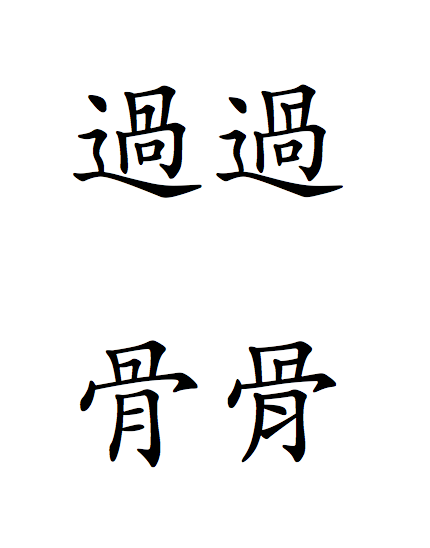The handwriting for the guo4 traditional character is incorrect. The little box enclosed in the bigger box should be on the left as in the character at the top of the screenshot not on the right as in the study practice.
Here’s an excerpt from the FAQ:
Why is the box on the left in 骨-- shouldn’t it be on the right? What about 過?
In simplified Chinese, it’s on the left. In traditional, it should be on the right, but many characters are shared with simplified, so for consistency we keep it on the left in the fully traditional characters. However, in the similar component in 過, we keep the box on the right, since that radical is not used in simplified
It looks like the font would need to be forced to use a different style than what’s currently being displayed to match the canvas.
i don’t understand the FAQ you are referencing - in Pleco and Wiktionary, the little box in the upper box is on the left, as it is in the Skritter (in the character at the top of the screen) - however, the drawing practice has the box on the right - that’s what I see as the bug - the strokes in the drawing practice should have the box on the left
Jeremy was referencing Skritter’s FAQ that goes back to when Skritter first started and sheds some light on why things can be a bit quirky sometimes.
過 being a perfect example.
The writing practice on Skritter has the box on the right, which is the way you would write it in Taiwan following the traditional version of the character. Writing the box on the left, like on Pleco, is based on a mainland font and writing style for the character, which is still represented in lots of fonts online, although now the simplified form is 过. Taking the two characters from the FAQ as an example, you can see two font styles next to each other for 過 and 骨.
The characters you study on Skritter are all hand mapped using an internal tool, and unfortunately, they don’t always match the font(s) that is displayed for the prompt or what you might see on other websites. We try our best to represent written Chinese the best we can, and we get like 99% of them right, but sometimes we’ve gotta make a choice and roll with it. Character variations, subtle font changes, etc. all can complicate things. We’d love to have all the fonts and strokes matching 100% correct, but it isn’t something we can support at the moment.
Unfortunately, you’ll have to make a mental note of the difference and keep that in mind when writing 過 and a few other characters. I do hope that we can patch up these descrepancies someday and make Skritter the perfect writing practice tool. Hopefully, the Chinese speakers in your life don’t give you too much trouble about it.
Cheers!
Jake
This topic was automatically closed 30 days after the last reply. New replies are no longer allowed.

